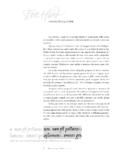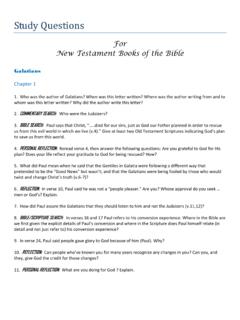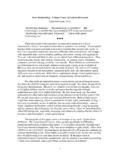Transcription of RHYTHM AND LETTERFORMS - Calligraphy …
1 RHYTHM AND LETTERFORMS . The left margins typed annotations will guide you through this lesson. The secret behind the exercises is repetition and slowness: repetition will eventually make you feel the natural RHYTHM of writing and slowness will help concentration and good forms. With time you will progressively get faster and eventually find your natural speed. The program should be followed in the order in which it is presented, this will help your learning process. We begin with RHYTHM exercises. 1. The exercise on the right 2. should have this RHYTHM : Slow vertical down stroke, brief stop without lifting the pen, quick curve up, brief stop without lifting the pen, slow vertical down stroke, and so forth. All the LETTERFORMS have similar 3.
2 Width with the exception of i, j, l that are narrower, and m, w that are wider. Monica Dengo 2005 Free Hand 4. 5. We are slowly starting to write 6. lettershapes. All the forms are con- nected, so you don't need to lift the pen, unless specified. Remember to write the downstrokes slower and and the upstrokes slightly faster. 7. Italic LETTERFORMS are compressed and 8. most of them have the same width. All forms are very similar to each other and most of them have the same structure. 10 Monica Dengo 2005 Free Hand The Italic letters can be joined to 9 form cursive writing, or be written separate as in this sentence. Although the focus of the course is on cursive, it is good to know both versions. In these exercises you'll learn all the 10.
3 Letters of the alphabet while writing them in a long word. We place the letter n between two subsequent letters in the alphabet in order to keep an even RHYTHM of spacing. The pen should never be lifted with the exceptions of: - horizontal stroke in f . - i and j dot - horizontal stroke in t . - the letter x . 11 Monica Dengo 2005 Free Hand Now that you know how to write 11. each letter, you'll have to learn how to connect them with one another. In many cases you'll be given more than one alternative, they are all good to know and helpful. In the eighteenth century the addressee was written on the outside of the folded letter and then sealed with wax. Often there is only a name, rather than the whole address, as below: [Al sig (nor) PietroJac (op) o Tani].
4 Note, after Tani a little wave and loopy descender to finish up the composition. Trace it to get a sense of the hand movement, note the freedom of expression! 12. 12 Monica Dengo 2005 Free Hand The dots show you where 13. you need to start the strokes. Scriveners had developed a natural 14. and spontaneous ability to play with their writing and create visually attractive forms, as you can see in B. the title Al Sasso . Trace sample C as shown in A . Each arrow indicates where the pen stroke begins. A C. 13 Monica Dengo 2005 Free Hand Continue to trace and copy. It's time to start with some 15. exercises to acquire RHYTHM and fluency! Use unlined paper. This is a very good exercise to do with music. 14 Monica Dengo 2005 Free Hand Continue to trace and copy.
5 The m RHYTHM can be even 16. freer than the previous o RHYTHM . Do this exercise playing with the space, so lines may not be straight and even overlap sometimes! 15 Monica Dengo 2005 Free Hand Continue to trace and copy. Do this mg exercise with 17. the same free spirit as the m exercise. Simply enjoy making lines, don't be concerned with legibility or good shapes. This exercise is mainly to help you loosen up. Do many of these exercises. 16 Monica Dengo 2005 Free Hand In your childhood you may have 18 3. learned cursive capitals with flourishes. Although very beautiful, they are often too complicated and difficult to memorize and personalize. Here are some very simple caps that work very well with cursive writing.
6 Below, the letter H at the left is often used as a cursive capital and in Italy it is taught by most teachers. This letter H has many parts that are flourishes, rather than structure, but people write it unaware of this distin- ction. On the contrary, the other two H are much clearer and simpler. One should always be aware of the basic structure in order to keep it legible and personalize it. It's time to do word rhythms! 19. 17 Monica Dengo 2005 Free Hand Continue to trace and copy. 18 Monica Dengo 2005 Free Hand A CLEAR LEGIBLE HAND. Note: It is often useful to write You are now ready to begin writing. You have been practicing with letter exercises in a language you shapes and letter spacing, you have also seen many of the most common do not know because you can focus more on lettershape and connections.
7 Now trace the text below and copy it as you did for the other rhythms and not revert to old, exercises. Then choose your own text and complete at least 4 full pages of bad writing habits. writing. Use the guide lines under your piece of paper, as you have been doing until your text at the same size and interline as the text below. 20. 19 Monica Dengo 2005 Free Hand These capitals with flourishes 21. are suited to be used in combination with cursive. Having practiced the basic forms of page 17 and 18, you can now clearly distinguish the basic structure from the flourish whose main function is to embellish the letter. Some historical capitals: Per . Note the beautiful capital shape and it's perfect legibility. La Citt.
8 Note the large L shape, which is the predominant mark and the C which is curiously going below the base line. Offerta . Note the capital O and the long f descenders. 20 Monica Dengo 2005 Free Ha








